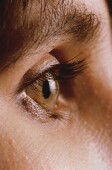Study Finds Potential Cause of Age-Related Macular Degeneration
Data could lead to new drugs to check vascular proliferation that is hallmark of eye disease.
By Jeffrey Perkel
HealthDay Reporter
|
E-mail this article
Subscribe to news
Printer friendly version
|

(SOURCES: Dean Y. Li, M.D., Ph.D., H. A. and Edna Benning Presidential Endowed Chair in Medicine, University of Utah, Salt Lake City; George A. Williams, M.D., chairman, Department of Opthalmology, William Beaumont Hospital, Royal Oak, Mich.; March 16, 2008, Nature Medicine, online)
MONDAY, March 17 (HealthDay News) -- Researchers have pinpointed a biological pathway that may block the blood vessel proliferation and leakiness behind most cases of blindness in the United States.
Though still preliminary, the University of Utah study suggests a new therapeutic target for such ophthalmic diseases as age-related macular degeneration (AMD) and diabetic retinopathy, as well as other conditions marked by inflammation and vascular leakiness, including cancer and certain traumatic injuries.
"I think it is very strong science," said Dr. George A. Williams, chairman of the department of ophthalmology at William Beaumont Hospital in Royal Oak, Mich. "It identifies a promising preliminary observation that is going to require a lot more development."
That observation involves a cell surface protein called Roundabout (Robo)-4. Other Robo family members play a role in neuronal growth and guidance, but Robo4 is different, said senior study author Dr. Dean Li, of the University of Utah, "mostly in that it was not expressed in nerves but in blood vessels."
Li has spent five years trying to understand the biology of Robo4. "We have been trying to figure out, why is this protein on blood vessels, and that is what this article answers -- what does this thing do?" he explained.
Li, along with Dr. Kang Zhang, also of the University of Utah, mutated the Robo4 gene in mice. They then characterized the behavior of cells from these mutant mice in response to the growth factor VEGF in the presence and absence of Robo4's binding partner, a protein called Slit2.
Normally, VEGF promotes angiogenesis, inducing vascular cell division, migration and vessel formation via its receptor. VEGF activity is responsible for normal vascular growth, but it also has a dark side, inducing the damage in AMD, diabetic retinopathy and other diseases.
The authors found that, in endothelial cells derived from normal mice, Slit2 inhibited these pro-angiogenic activities, blocking both cell migration and vessel leakiness. In cells derived from Robo4-mutant mice, however, Slit2 had no effect -- the cells responded to VEGF as if Slit2 was not even there. These findings suggest that Slit2's function is to put the brakes on VEGF activity via its interaction with Robo4.
The study was published in the March 16 online edition of Nature Medicine.
"What we are saying is the cells of the blood vessels have a protein receptor, and this is called Robo4, and if you activate the Robo4 receptor, by giving it a protein that binds to it, the blood vessel cells know the cells shouldn't leak and grow," Li said.
According to Li, that idea makes sense biologically.
"In everything in biology, there is a yin and a yang," he said. Just as there are factors that induce vascular growth and destabilization, there must also be factors to dampen that effect, "because every time you get sick and have interleukins in the body, you don't want the vasculature to destabilize. You want a balance between stabilization and destabilization."
Several drugs targeting the VEGF-signaling pathway have already been approved by the U.S. Food and Drug Administration, including Avastin, Lucentis and Macugen. Li said the Robo4/Slit2 biological pathway presents an alternative therapeutic target.
"You can block the destabilizing/regenerative factors [like VEGF]," he said, "but another way of doing it is to activate a signal to block destabilization. And I think this is the first proof of principle that this is a viable therapeutic option."
The study "identifies a new pathway by which we may be able to further inhibit VEGF-mediated effects," agreed Williams. "And if that is in fact true -- and the data look very compelling in this publication -- then there is potential that this could represent a new mechanism by which we could inhibit the role of VEGF in neovascular AMD."
Indeed, the authors tested that theory directly, by injecting Slit2 protein into the eyes of mouse models of AMD and diabetic retinopathy. In both cases, Slit2 reduced the angiogenesis that is a hallmark of disease.
But Williams noted that this same approach would not likely be viable therapeutically. Instead, a Slit2 molecular agonist (that is, a molecular mimic) would need to be developed and tested in humans -- a process that could take a decade or more before arriving in the clinic, he said.
AMD is the leading cause of blindness in Americans over the age of 55, according to the American Macular Degeneration Association, affecting more than 10 million individuals.
More information
For more on diseases of the eye, visit the U.S. National Eye Institute.
Copyright © 2008 ScoutNews, LLC. All rights reserved. 
HealthDayNews articles are derived from various sources and do not reflect federal policy. healthfinder.gov does not endorse opinions, products, or services that may appear in news stories. For more information on health topics in the news, visit the healthfinder.gov health library.